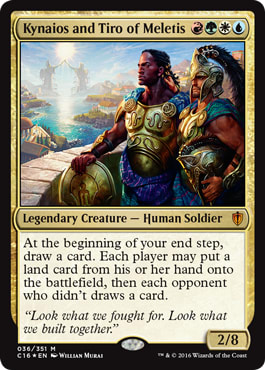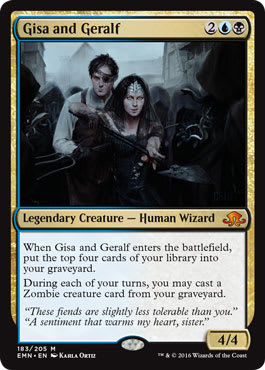Upon the release of Theros in 2013, players quickly noticed something about the statues depicted on the card Guardians of Meletis: both the statues were male. This was noteworthy because the flavor text described the two figures as "peaceful lovers." Magic had its first on-card explicit depiction of queerness. While their story was, per the flavor text, lost to history, Magic has ways of going back in time, and Commander 2016 capitalized on its ability to jump into the storyline's past by giving the characters in the flesh, triumphantly overlooking the city they founded.
For me, Kynaios and Tiro of Meletis, the card in question, isn't just interesting from a representation standpoint. I mean, don't get me wrong, this is a great step for the game and significant in its own right! But as I discussed last time, I'm deeply fascinated by the way cards convey narrative information to players. And when you're trying to get across the fact that yes, these characters are definitely queer, you've got to use all the information at your disposal in a way that still seems artful. This card is a major success on that front, but it's worth taking some time, I think, to dig into why.
Now, when I say that this card is artful, what I don't mean is that this card is good because it's not "in your face" — a phrase I see dropped into conversations about representation pretty regularly. I don't really agree that "not making a big deal about diversity" is something really worth striving for, for a host of reasons, the biggest one being that identity is meaningful primarily because of the different experiences that identities engender. Diversity without any narrative impact is therefore intrinsically kind of superficial.
But more than that, it's actually somewhat surprising to me to see this card in particular described by folks online as an example of representation that isn't "in your face." It's odd in part because for some people it DOES seem to have been too aggressive (I've seen complaints about Tiro's hand tangled in Kynaios's hair in the art, for example) but also because from my perspective, this card seems almost semiotically overdetermined: the components of the card are very carefully oriented toward conveying a particular narrative about these characters. What we have here is not meek subtlety or superficiality — what makes the card work is the careful weaving together of elements in an artful way.
Key to understanding this, I think, is the fact that the card sets out to meet not the two basic goals you'd expect — depict a canon queer relationship, while also producing a card with interesting gameplay — but a whole host of OTHER goals as well, and tricky goals at that! The card ALSO has to fill a four color legend slot for the purposes of the Commander/EDH format, and on top of that it has to convey something hard to depict in a game about wizards throwing baloths at each other's heads: it has to depict love.
It's possible to handle a lot of this through context. This is something that I talked about extensively in my coverage of Magus of the Will: that card conveyed loads of storyline information in a small space by making allusions to other cards. The field of communication for a Magic card is not just the card itself, but all the other cards — all the other clusters of symbolic information — that can be drawn into association with it. We absolutely see that with Kynaios and Tiro of Meletis.
The biggest context of all, of course, is the Guardians of Meletis card, which already reveals that the kings depicted in the statues were lovers. People realized pretty much immediately once the name was released that Kynaios and Tiro were probably the kings depicted in the previous card, but the new legend goes out of its way to give even non-Vorthos players the tools needed to make the connection. Most obviously, the Guardian statues are depicted in the background of the new art — not complete but being erected, monuments being built. It's fairly trivial to realize the implications once you see the two cards side by side. And, of course, even though it's a small thing, the "of Meletis" ending also invites comparison through parallelism. Minor, yes, and obvious, but it's doing symbolic work here, conveying another piece of information.
The Guardians weren't the only giveaway, though. In another instance of players piecing things together quickly, various folks realized that there was a striking parallel between Kynaios and Tiro and two other Theros rulers: Anax and Cymede. According to Kelly Digges, this was absolutely deliberate, a clever idea from Jeremy Jarvis. It works perfectly. What better way to convey "these two rulers are a couple" than to deliberately paint them in parallel to a previously established couple from the same plane, many centuries later? It's a really wonderful callback (or, I suppose, call-forward, in storyline chronology) and it's a great way of hammering home the fact that this is romantic rather than just two guys bein' dudes.
You should be catching on already to some of how this card operates in order to solve multiple design problems (and flavor is certainly a critical aspect of design!): Commander 2016's designers have created — and I apologize in advance for this — a kind of house of cards, both in the sense that many different pieces of information external to the single legend, and in the sense that they've essentially pitted design problems against each other. How to convey a story about established characters? Rely on references to other instances of romance. How do you convey romance? Show characters in a relationship already established. Design problems balanced against each other and braided together.
Moving into actual gameplay stuff, this card's mana cost is a great example of this principle of balancing design problems against each other. How do you come up with a four color legend? After all, four colors tends to feel uneven to many players (and designers), unbalanced. How do you represent just one color being missing without it feeling like a five color card arbitrarily cropped down, or a three color card with an extra color arbitrarily dropped in?
One way to do it is to just have two characters on the same damn card. I think what we see in Tiro and Kynaios is two characters with different color alignments bonded together. It's an easy leap to make, I think, because of context again. This card was released in a set whose star mechanic allowed players to have two legends as their commander, rather than the normal one. This is all about pairing people up, and while it's tragic that we didn't get to see the necro-alchemist Ludevic finally make an honest man of Geralf, the theme comes through loud and clear throughout Commander 2016.
So, the card can, with the help of its wider setting, check another two design problems off by answering them with each other, braiding them together. How do you convey two people bonded together? Through an unusual mana cost. How do you justify four colors? Through two characters joined as one.
And then of course there's the ability itself. Now, I hear rumors that sometimes people . . . "play" . . . Magic the Gathering. I've never seen it done myself, but I get that in theory you could look at these cards as something other than big fancy metaphorical art projects. And if you DID do that, I think it's easy to see how the "group hug" ability here fits in. It's an ability that primarily benefits the player who summons Tiro and Kynaios, but also helps out everyone at the table. Everyone at the table gets to choose to either play a land, or to draw a card. You get to do both. As the flavor text suggests, Kynaios and Tiro are building a better world, a world — as we learn in the Mothership overview of all the Commanders — freed by the two heroes and their people from a tyrannical Archon empire. The two kings have their priorities, certainly, but this card is about coming together for an idealistic goal.
It's no accident that the one color not represented here is the color most associated with selfishness. If this is a card about love, in some sense, it is also a card about selflessness, love as giving, love as joining with others, love as flooding the field with a bunch of snake tokens — wait really?
Huh.
Yeah, apparently giving everyone loads of snake tokens is an optimal outcome here, according to Tom Delia. And look at the language he uses there: "I would put an absolute priority on Horn of Greed if you intend to enliven the game for each player in your playgroup." The priority is making the match more fun for everyone. Sounds pretty RGWU to me!
What we have here then is a card that weaves all its individual elements together, using context and reference to other cards as the warp that the weft of card art, flavor text, ability, cost, power, and toughness is drawn through, in order to convey love, selflessness, and the bond between two men. This focus on love is remarkable in itself: after all, designers like Mark Rosewater have sometimes noted that conveying emotions other than "face smash" on cards is difficult, given that this is a game so driven by, well, face smashing. A LOT of effort has gone into making that different tone and focus read properly and, importantly, unambiguously. There's no mistaking this for anything BUT love.
Face smashing of a different sort nyuk nyuk nyuk
And the threads of this card have been woven together in order to show a love that is absolutely, undeniably queer. That honestly means a lot. Tiro and Kynaios's relationship to one another can't be ignored or brushed away because it's, I mean, it's literally the whole card, down to even the most Melviny mechanical level. That's artful. That's . . . art! Art that doesn't end where the card's illustration ends. And I appreciate Wizards making an effort to produce a card that is not only representation of a queer experience, but this big fancy metaphorical art project where that queer experience remains meaningful, integral, and powerful.



























